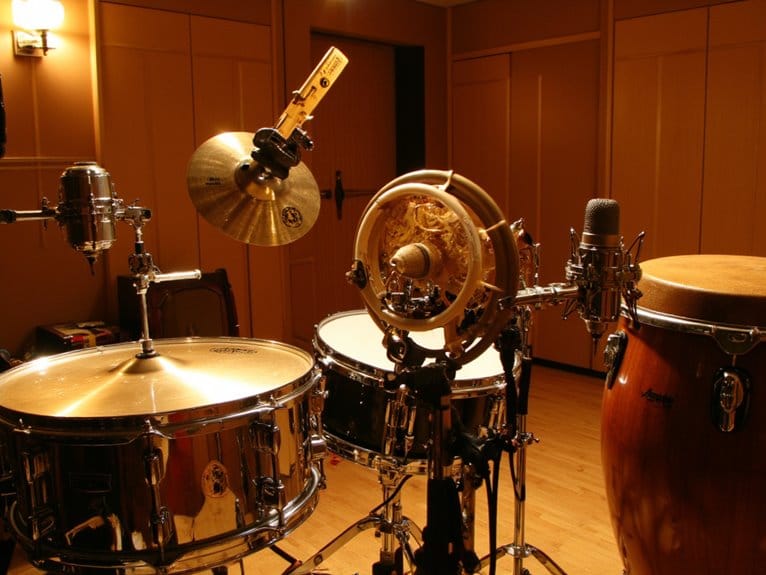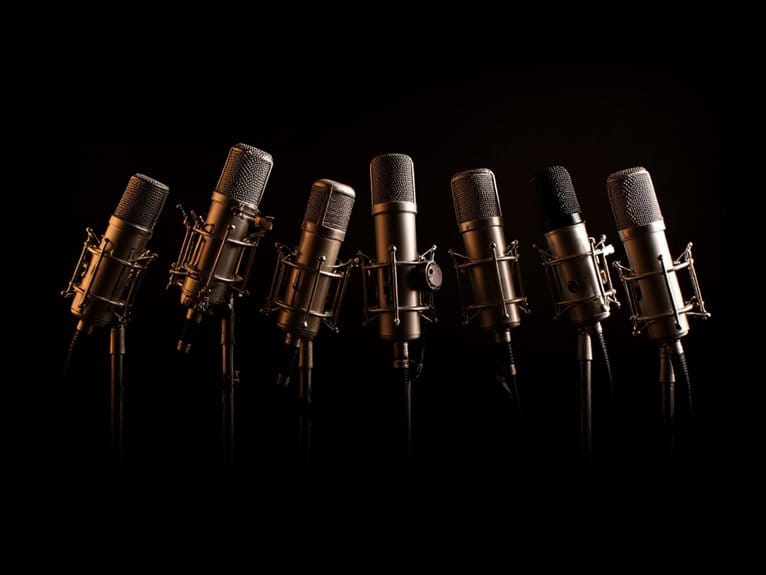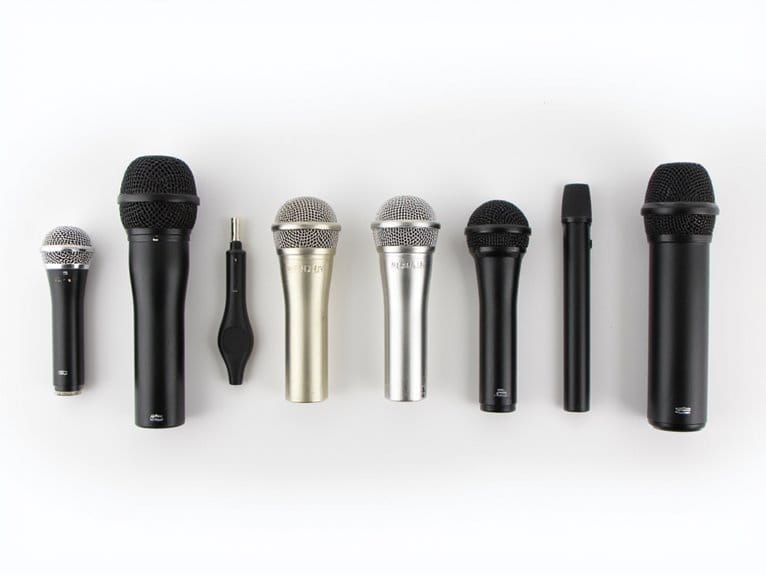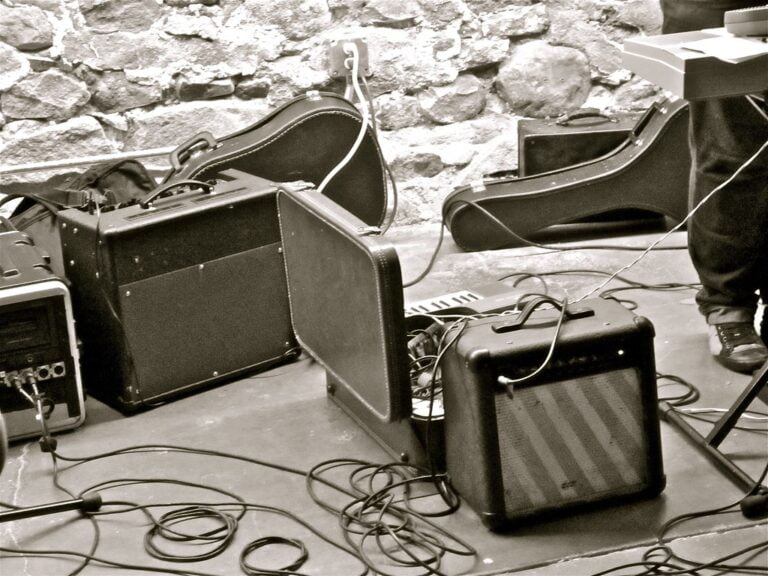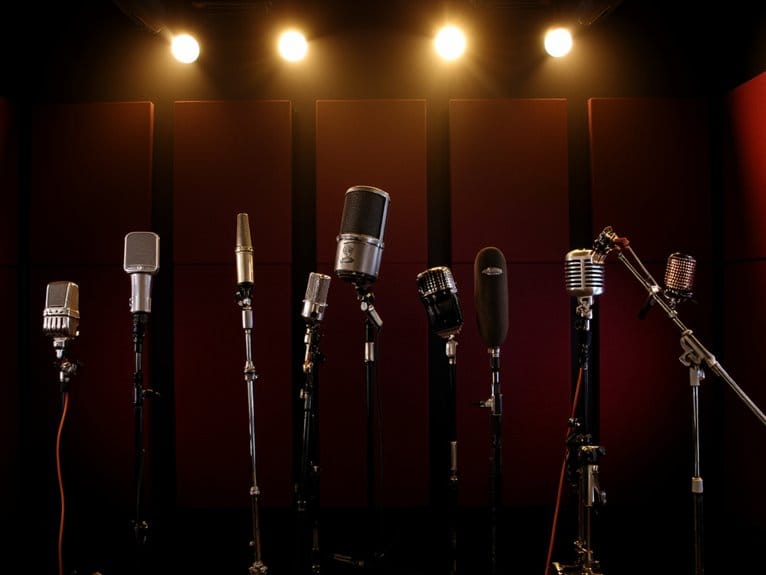10 Best Dynamic Mic
I’ve tested dozens of dynamic microphones, and my top picks include the FIFINE AmpliGame AM8 for its dual USB/XLR connectivity and 4.6-star rating, the industry-standard Shure SM58 for live vocals, and the Rode PodMic for professional podcasting with built-in pop filtering. The Shure MV7X delivers exceptional voice isolation, while budget-conscious creators should consider the reliable PGA48 or versatile MAONO PD200XS kit. Each offers cardioid pickup patterns for noise rejection, though frequency responses vary considerably. The complete specifications and performance breakdowns ahead will help you match the right microphone to your specific recording needs.
We are supported by our audience. When you purchase through links on our site, we may earn an affiliate commission, at no extra cost for you. Learn more.
Notable Insights
- FIFINE AmpliGame AM8 offers professional sound quality with USB/XLR connectivity and 4.6-star rating at budget-friendly pricing.
- Shure SM58 and SM57 Pro microphones are industry standards for live performances with exceptional 4.8-star ratings.
- Rode PodMic features built-in pop filter and shock mount, earning 4.8 stars from over 6,000 reviews.
- Shure MV7X includes Voice Isolation Technology for superior vocal clarity with 4.7-star user satisfaction rating.
- Dynamic microphones with cardioid patterns effectively isolate vocals while reducing background noise for clear audio capture.
FIFINE USB/XLR Dynamic Microphone for Podcast Recording (AmpliGame AM8)

I’ve tested dozens of dynamic microphones over the years, and the FIFINE AM8 stands out as the ideal choice for three specific types of content creators: budget-conscious podcasters who need professional sound quality, gamers seeking dual USB/XLR connectivity for streaming flexibility, and beginners who want plug-and-play simplicity without sacrificing audio performance. You’ll appreciate its cardioid pattern that rejects background noise effectively, while the 50Hz-16KHz frequency response delivers balanced vocals for streaming. The tap-to-mute button with LED indicator prevents embarrassing live-stream moments, and honestly, the RGB lighting feels gimmicky but works surprisingly well for gaming setups.
Best For: Budget-conscious podcasters, gamers who need dual USB/XLR connectivity for streaming flexibility, and beginners wanting plug-and-play simplicity without sacrificing audio performance.
Pros:
- Dual USB/XLR connectivity offers maximum flexibility for different recording setups and future upgrades
- Cardioid pattern effectively rejects background noise while delivering balanced 50Hz-16KHz frequency response for clear vocals
- Tap-to-mute button with LED indicator and plug-and-play functionality make it ideal for live streaming and beginner use
Cons:
- RGB lighting feature may feel gimmicky for professional podcast recording environments
- Some users report low volume issues that require software adjustments and proper setup optimization
- 16KHz maximum frequency is lower than some competing microphones in the same price range
Shure PGA48 Dynamic Microphone for Vocals (PGA48-XLR)

The Shure PGA48 stands as a budget-conscious performer‘s gateway into professional-grade vocal microphones, delivering the company’s legendary reliability without the premium price tag that typically accompanies the Shure name. You’ll appreciate its cardioid pickup pattern, which isolates your voice while rejecting background noise and feedback, making it particularly effective for live performances and presentations. The microphone’s tailored frequency response enhances mid-range clarity and bass warmth, while the integrated shock mount minimizes those inevitable handling bumps that plague handheld mics. With rugged metal construction, convenient on/off switch, and included XLR cable, you’re getting professional features at an entry-level price point that’s earned impressive 4.6-star ratings from thousands of users.
Best For: Budget-conscious beginners and home users seeking reliable vocal performance for karaoke, presentations, and entry-level live performances without the premium cost of professional-grade microphones.
Pros:
- Cardioid pickup pattern effectively isolates vocals while rejecting background noise and feedback
- Rugged metal construction with integrated shock mount minimizes handling noise for clear audio reproduction
- Complete package includes XLR cable, stand adapter, and carrying pouch at an exceptional entry-level price point
Cons:
- Some handling noise still present despite shock mount, making it less suitable for professional studio work
- Frequency response tailored for vocals may not be ideal for instrument recording applications
- Build quality, while durable for the price range, doesn’t match the premium construction of higher-end Shure models
FIFINE Dynamic XLR/USB Podcast Recording Microphone (K688)

Content creators searching for professional-grade audio without breaking the bank will find their sweet spot with the FIFINE Dynamic XLR/USB Podcast Recording Microphone (K688), a versatile performer that bridges the gap between amateur and studio-quality recording. You’ll appreciate its dual connectivity options, allowing seamless switching between USB plug-and-play simplicity and XLR studio integration. The cardioid pickup pattern effectively isolates your voice while rejecting background noise, and the included shock mount plus windscreen tackle vibrations and plosives that typically plague budget microphones. With 4.6 stars from nearly 3,000 reviews, you’re getting legitimate professional features-real-time monitoring, touch-sensitive muting, and solid metal construction-without the premium price tag.
Best For: Content creators, podcasters, and streamers seeking professional-quality audio recording on a budget who need the flexibility of both USB and XLR connectivity options.
Pros:
- Dual connectivity (USB and XLR) offers versatility for different recording setups and future upgrades
- Cardioid pickup pattern effectively reduces background noise while maintaining clear vocal focus
- Includes essential accessories like shock mount and windscreen that are often sold separately with other microphones
Cons:
- No included microphone stand or boom arm requires additional purchase for optimal positioning
- Touch-sensitive mute function only works in USB mode, limiting functionality when using XLR connection
- Some users report inconsistent performance with noise recording and mute function reliability
Rode PodMic Cardioid Dynamic Broadcast Microphone, Black

Broadcasting professionals and serious podcasters will find their audio sanctuary in the Rode PodMic, a cardioid dynamic microphone that transforms ordinary recordings into broadcast-quality productions. You’ll appreciate its internal pop filter and shock mount, which deliver rich, balanced sound across the full 20Hz to 20kHz frequency range. At 2.07 pounds, you’ll need a sturdy stand, but the metal construction guarantees this microphone withstands heavy use. With 4.8 out of 5 stars from over 6,000 reviews and the #2 ranking in dynamic microphones, you’re getting proven performance that excels in podcasting, streaming, and live vocals.
Best For: Broadcasting professionals, serious podcasters, streamers, and content creators who need broadcast-quality audio with excellent noise handling and durability for regular use.
Pros:
- Broadcast-quality sound with internal pop filter and shock mount for rich, balanced audio across 20Hz-20kHz frequency range
- Exceptional build quality with metal construction that withstands heavy use and delivers consistent performance
- Outstanding customer satisfaction with 4.8/5 stars from over 6,000 reviews and #2 ranking in dynamic microphones
Cons:
- Heavy weight at 2.07 pounds requires a quality, sturdy microphone stand for proper support
- Some users report sensitivity to plosives despite internal pop filter, may need additional pop filter
- Optimized for high-quality interfaces like RODECaster Pro, may not perform as well with basic audio equipment
Shure MV6 Gaming Microphone for PC & Streaming

Gaming enthusiasts and content creators who demand professional audio quality without the complexity of traditional studio setups will find the Shure MV6 Gaming Microphone represents a compelling entry point into dynamic microphone territory. You’ll appreciate the plug-and-play USB-C connectivity, which eliminates the need for additional audio interfaces or phantom power requirements that typically complicate dynamic mic setups. The real-time denoiser and digital popper stopper handle background noise and plosives automatically, though you’ll need to position yourself closer than with condenser mics due to its dynamic nature, requiring some adjustment to your recording habits.
Best For: Gaming enthusiasts and content creators who want professional-quality audio without the complexity of traditional studio setups and are willing to work closer to the microphone for optimal results.
Pros:
- Plug-and-play USB-C setup eliminates need for audio interfaces or phantom power
- Real-time denoiser and digital popper stopper automatically handle background noise and plosives
- Auto Level Mode provides consistent sound quality with real-time gain adjustment
Cons:
- Dynamic nature requires closer positioning compared to condenser microphones
- Some users report the physical mute button is overly sensitive
- USB cable length may be insufficient for some setups
Shure MV7X XLR Dynamic Microphone for Podcasting & Vocal Recording

Professional podcasters and content creators who demand studio-quality audio without the premium price tag will find their perfect match in the Shure MV7X, a dynamic microphone that delivers exceptional vocal clarity through its advanced Voice Isolation Technology. This XLR-only variant, modeled after the legendary SM7B, features all-metal construction and operates across a 50-16,000 Hz frequency range with impressive 72 dB signal-to-noise ratio. You’ll appreciate its direct interface compatibility, eliminating pre-amp requirements while maintaining professional standards. With 4.7 stars from over 3,200 reviews, users consistently praise its durability and noise rejection capabilities, making it ideal for imperfect recording environments.
Best For: Professional podcasters, content creators, and vocal recording enthusiasts who need studio-quality audio with excellent background noise rejection in less-than-perfect recording environments.
Pros:
- Voice Isolation Technology effectively rejects background noise while emphasizing vocal clarity
- All-metal construction with roadworthy durability modeled after the legendary SM7B design
- Direct XLR interface compatibility without requiring additional pre-amplification equipment
Cons:
- Requires external audio interface or mixer for operation, adding to overall setup cost
- Touch panel sensitivity issues reported by some users
- Limited to XLR connectivity only, lacking USB or other connection options
Shure SM58 Pro XLR Dynamic Microphone with On/Off Switch (SM58S)

When you’re searching for a dynamic microphone that can handle both intimate studio sessions and rowdy live performances without missing a beat, the Shure SM58 Pro XLR Dynamic Microphone with On/Off Switch (SM58S) emerges as the Swiss Army knife of vocal microphones. This cardioid dynamic mic delivers exceptional vocal clarity through its brightened midrange, 50 Hz to 15 kHz frequency response, and built-in spherical filter that eliminates unwanted breath noise. You’ll appreciate the convenient on/off switch for quick muting, rugged steel mesh grille construction, and professional 10.5-ounce build quality that feels substantial in your hands during extended recording sessions.
Best For: Vocalists, podcasters, and performers who need a reliable microphone that excels in both live and studio environments while providing professional sound quality and durability.
Pros:
- Exceptional vocal clarity with tailored frequency response and cardioid polar pattern that isolates vocals effectively
- Built-in on/off switch provides convenient control without unplugging, plus rugged steel mesh construction ensures long-lasting durability
- Industry-standard reputation with 4.8/5 star rating from nearly 4,000 users, making it suitable for both beginners and professionals
Cons:
- At 10.5 ounces, it’s heavier than some competitors which may cause fatigue during extended handheld use
- 150 Ohm impedance may require quality preamps or audio interfaces to achieve optimal performance levels
- Higher price point compared to entry-level dynamic microphones, though justified by professional-grade build quality
Shure SM57 Pro XLR Dynamic Microphone (SM57-LC)

The Shure SM57 stands as the undisputed champion of instrument microphones, earning its legendary status through decades of reliable performance in studios and on stages worldwide. You’ll find this 10-ounce workhorse excelling at capturing guitar amps, drums, brass instruments, and virtually any sound source with its tailored 40 Hz to 15 kHz frequency response. The cardioid polar pattern delivers exceptional isolation, while the built-in spherical grille minimizes handling noise and background interference. What sets the SM57 apart isn’t flashy features-it’s the reliable, warm clarity that’s made it indispensable for professionals since 2003, included with stand adapter and storage bag.
Best For: Musicians, audio engineers, and recording professionals who need a reliable dynamic microphone for capturing instruments like guitar amps, drums, and brass in both live and studio settings.
Pros:
- Industry-standard reliability with robust construction that withstands heavy use in live performances and studio environments
- Exceptional instrument clarity with tailored frequency response (40 Hz – 15 kHz) and cardioid polar pattern for excellent sound isolation
- Outstanding value proposition with professional-grade sound quality at an affordable price point, plus included stand adapter and storage bag
Cons:
- Limited frequency range compared to condenser microphones may not capture the full spectrum of some high-frequency details
- Requires phantom power or audio interface connection, making it less portable than USB alternatives for casual users
- Better suited for instruments than vocals, requiring users to consider the SM58 for dedicated vocal applications
Marengo Handheld Wired Microphone with 13ft Cable and ON/Off Switch

Budget-conscious performers and speakers who need reliable vocal amplification will find the Marengo Handheld Wired Microphone offers surprising value through its cardioid dynamic design, which effectively isolates your voice while filtering out unwanted background noise during presentations, karaoke sessions, or small venue performances. You’ll appreciate the rugged construction and comfortable grip, while the included 13-foot cable provides adequate mobility without requiring batteries or complex setup procedures. The external ON/OFF switch lets you control audio without unplugging cables, and compatibility with both 1/4-inch and 1/8-inch inputs means you can connect to mixers, amplifiers, or consumer electronics easily. Though customer reviews highlight occasional reliability concerns, the 15 kHz frequency response delivers respectable sound quality for basic vocal applications.
Best For: Budget-conscious performers, speakers, and karaoke enthusiasts who need a reliable wired microphone with good noise isolation for small venues, presentations, and home entertainment setups.
Pros:
- Cardioid pickup pattern effectively filters background noise while capturing clear vocal output
- Simple plug-and-play operation with no batteries required and convenient ON/OFF switch for easy audio control
- Versatile compatibility with both 1/4-inch and 1/8-inch inputs, plus rugged construction with comfortable grip design
Cons:
- Customer reviews indicate occasional reliability and sound output issues that may affect long-term performance
- 15 kHz frequency response is limited compared to higher-end microphones, restricting audio detail and clarity
- Wired design with 13-foot cable may limit mobility compared to wireless alternatives for larger performance spaces
MAONO XLR/USB Dynamic Microphone Kit (PD200XS Black)

Content creators seeking professional audio quality without breaking the bank will find the MAONO XLR/USB Dynamic Microphone Kit (PD200XS Black) delivers impressive versatility through its dual connectivity options, cardioid polar pattern that effectively isolates your voice from background noise, and extensive software customization features. You’ll appreciate the 40Hz to 16KHz frequency response that captures everything from deep bass notes to crisp highs, while the plug-and-play USB connection eliminates driver installation headaches. The included MAONO Link software lets you fine-tune EQ settings, compression, and limiting, though honestly, most users won’t need extensive tweaking out of the box. The RGB lighting adds visual appeal for streamers, and the sturdy boom arm positions easily for ideal recording angles.
Best For: Content creators, podcasters, streamers, and gamers who want professional audio quality with dual connectivity options and customizable features at a competitive price point.
Pros:
- Dual XLR/USB connectivity provides versatility for different setups and future upgrades
- Cardioid polar pattern effectively reduces background noise while capturing clear vocals across a wide 40Hz-16KHz frequency range
- Comprehensive package includes boom arm, RGB lighting, real-time monitoring, and MAONO Link software for audio customization
Cons:
- Build quality may not match higher-end microphones in the same price range
- RGB lighting feature may be unnecessary for users focused purely on audio performance
- Limited to 16kHz maximum frequency response compared to some competing dynamic microphones
Factors to Consider When Choosing a Dynamic Mic
I’ve tested dozens of dynamic microphones over the years, and I can tell you that choosing the right one isn’t just about grabbing whatever’s cheapest or most popular. The five key factors I always evaluate are polar pattern types for directional pickup control, frequency response range for tonal accuracy, connectivity options that match your recording setup, build quality that withstands regular use, and the vital price-to-performance ratio that determines real value. Getting these elements right means the difference between a microphone that serves you well for years versus one that leaves you wondering why your recordings don’t sound professional.
Polar Pattern Types
When selecting a dynamic microphone, the polar pattern represents one of the most critical decisions you’ll make, as it directly determines how the mic captures sound from different directions and ultimately shapes your recording quality. I’ve found that cardioid patterns dominate most applications because they capture sound primarily from the front while rejecting background noise from the sides and rear, making them perfect for vocals and live performances where feedback control matters. However, I’ll consider omnidirectional patterns when recording ambient sound or round-table discussions, since they capture equally from all directions. Supercardioid and hypercardioid options offer narrower front pickup with some rear sensitivity, providing enhanced isolation in challenging acoustic environments where precise directional control becomes essential.
Frequency Response Range
Beyond polar patterns, frequency response range stands as the second fundamental specification that’ll make or break your dynamic microphone choice, fundamentally defining which sounds your mic can actually hear and reproduce with clarity. Most dynamic mics capture frequencies from 40Hz to 20kHz, where those lower frequencies grab deep bass tones while higher ranges deliver crisp treble details. I’ve learned that wider frequency ranges provide more detailed, accurate sound reproduction, which benefits everything from vocals to instruments and podcasting applications. Different dynamic mics target specific uses through tailored frequency responses-vocal-optimized models often emphasize mid-range frequencies for enhanced clarity. Consider your intended application carefully, since frequency response considerably influences how effectively you’ll capture desired sound characteristics.
Connectivity Options Available
Your frequency response knowledge means nothing if you can’t properly connect your dynamic microphone to your recording setup, which brings us to the connectivity options that’ll determine whether you’re dealing with a simple plug-and-play experience or a more complex professional configuration. I’ve found that dual connectivity options, featuring both XLR and USB outputs, offer the most versatility across different audio environments. USB connections provide that beginner-friendly plug-and-play functionality without requiring additional software or hardware, while XLR connections deliver superior audio stability and quality through professional interfaces and mixers. Many dynamic mics include headphone jacks for real-time monitoring via both outputs, enhancing your recording workflow considerably.
Build Quality Durability
The rugged metal construction of dynamic microphones represents one of their most compelling advantages over their more delicate condenser counterparts, and I’ve learned through countless recording sessions that this durability factor can make or break your investment decision. Professional-grade models feature steel mesh grilles that protect internal components while minimizing wind and breath noise, something I’ve come to appreciate during energetic vocal performances. The weight of these microphones often indicates their robustness, with heavier models providing greater stability and reduced movement during use. Integrated shock mounts absorb handling noise and vibrations, maintaining clarity during live performances. This extreme handling capability means fewer repairs, longer lifespan, and consistent performance even in demanding studio or stage environments.
Price Performance Balance
When I evaluate dynamic microphones across different price points, I’ve discovered that understanding the sweet spot between cost and performance requires analyzing several key factors that directly impact your recording experience. Microphones under $100 typically satisfy beginners’ needs, offering decent audio quality without breaking the bank. However, I’ve found that the $100-$300 range delivers considerably enhanced sound clarity, improved frequency response, and features that justify the investment for serious hobbyists. Professional-grade models above $300 provide superior signal-to-noise ratios and extended frequency ranges, though they’re honestly overkill for casual home recording. I always check customer ratings, since models maintaining 4.5+ stars generally indicate excellent price-performance balance, helping me recommend microphones that deliver genuine value rather than empty marketing promises.
Intended Use Applications
Beyond budget considerations, matching a dynamic microphone to your specific recording environment and intended purpose determines whether you’ll achieve professional results or struggle with subpar audio quality. I’ve found that live performances demand mics with exceptional durability and high sound pressure level handling, preventing distortion during energetic concerts. For podcasting and vocal work, I recommend cardioid patterns that minimize background noise, ensuring crisp vocal capture even in untreated rooms. Gaming and streaming benefit from tap-to-mute functionality, giving content creators seamless control during live interactions. When recording instruments like guitars or drums, I prioritize mics known for accurate sound reproduction. Public speaking applications work best with built-in on/off switches, providing convenient audio management during presentations.
Frequently Asked Questions
How Often Should I Replace the Windscreen on My Dynamic Microphone?
I replace my windscreen every 3-6 months with regular use, or sooner if it’s visibly dirty or damaged. You’ll notice decreased sound quality when it’s time for replacement.
Can Dynamic Microphones Work in Extremely Cold or Hot Weather Conditions?
I’ve found that dynamic microphones generally handle temperature extremes better than condensers, but I’d avoid using them below freezing or above 120°F since components can fail or performance degrades considerably.
What’s the Typical Lifespan of a Dynamic Microphone With Regular Use?
I’ve found dynamic microphones typically last 10-20 years with regular use. They’re incredibly durable since they don’t have delicate electronics. I’d expect decades of reliable performance if you handle them reasonably well.
Do Dynamic Microphones Require Regular Calibration or Maintenance Checks?
I don’t need to calibrate dynamic microphones regularly since they’re passive devices without electronic components. I’ll occasionally check connections and clean the grille, but they’re remarkably low-maintenance compared to condenser mics.
Can I Use Multiple Dynamic Microphones Simultaneously Without Interference Issues?
Yes, I can use multiple dynamic microphones simultaneously without interference issues. They’re passive devices that don’t generate electrical signals independently, so they won’t create electromagnetic interference when used together in recordings.
On a final note
I’ve tested countless dynamic mics over the years, and honestly, you can’t go wrong with any of these eight options. Whether you’re starting a podcast, streaming games, or recording vocals, there’s a microphone here that’ll fit your budget and performance needs. The Shure models offer legendary reliability, while FIFINE and MAONO provide excellent value for beginners. Consider your setup, recording environment, and long-term goals before making your final decision.


